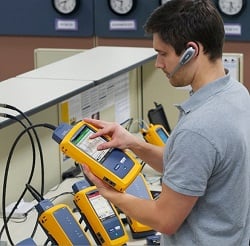Let’s All Calibrate and Have a Good Time!
April 4, 2018 / General, Standard and Certification, Best Practices
Just like those who drive around long after the engine service indicator lights up on the dashboard, there are folks out there who have likely been putting off getting their t

ester calibrated despite the email or LinkWare™ Live notification from Fluke Networks.
And just like your car, we understand that you might question whether calibration is REALLY needed or if you can put it off a little longer. We also understand that just like when your car is in the shop, you can’t use your tester when it’s out for calibration (unless of course you have a free loaner which comes with getting your car serviced at the dealership, or in the case of your tester, with membership in Fluke Networks Gold support program).But just like not changing the oil in your car, not getting your tester calibrated can ultimately cost you more. Let’s take a closer look.
Why Does It Even Need to be Calibrated?
Like your car’s oil can wear out over time and become less effective at properly lubricating the engine, your Fluke Network tester’s components can deviate from their original behavior. Part of the process of designing an accurate tester is determining what the appropriate calibration interval should be. We do that by reviewing specifications as well as looking at real world experience with the thousands of testers we have out there. As with any electronic, resistors, capacitors and circuits can drift over time due to temperature, humidity and warming up and cooling down every time you turn your tester on and off. The circuit boards within the tester can also be contaminated by dust or other materials.
And do you remember that time when you accidently dropped your tester on the cement TR floor, or when you had to stop short and it slid off your passenger seat onto the floor of the van? How about when it spent a weekend in the truck in subzero temperatures or those really hot August days? While it’s designed to keep working even after these kinds of shocks, it may not be as accurate as it was originally.
Sometimes calibration is simply required. If you are ISO 9001-certified, any measuring equipment you use to verify or control quality must be calibrated. And to warranty a system, cabling and connectivity manufacturers typically require test data using instruments with a valid calibration.
It Can Cost You More to Put It Off
If you ever had a major break down or seized engine due to putting off changing the oil, you know that it ultimately ended up costing you more in the long run. Putting off calibration of your tester is no different. Not only could you risk voiding a system warranty, but imagine what can happen when your tester yields false passes of bad links or false fails on good links.
If your uncalibrated tester passes bad links and you provide your customer with incorrect results, they will likely require you to come back and make repairs, or worse, they might bring legal action against you. And if you fail good links, you’ll be spending time troubleshooting and fixing links that don’t need it. In either case, you’re losing time and money, not to mention the potential for dissatisfied customers.
A properly-calibrated tester is the smart choice that can ultimately save you money. And the right place to get your Fluke Networks tester calibrated is at one of our 13 authorized service centers throughout the world where you’re guaranteed a quality calibration, product-specific knowledge and a thorough adjustment, repair and firmware update to ensure that your tester works as well as it did the first time you ever used it. Now that’s something to celebrate.
Click HERE to learn more about calibration and locate a Fluke Networks authorized service center.






